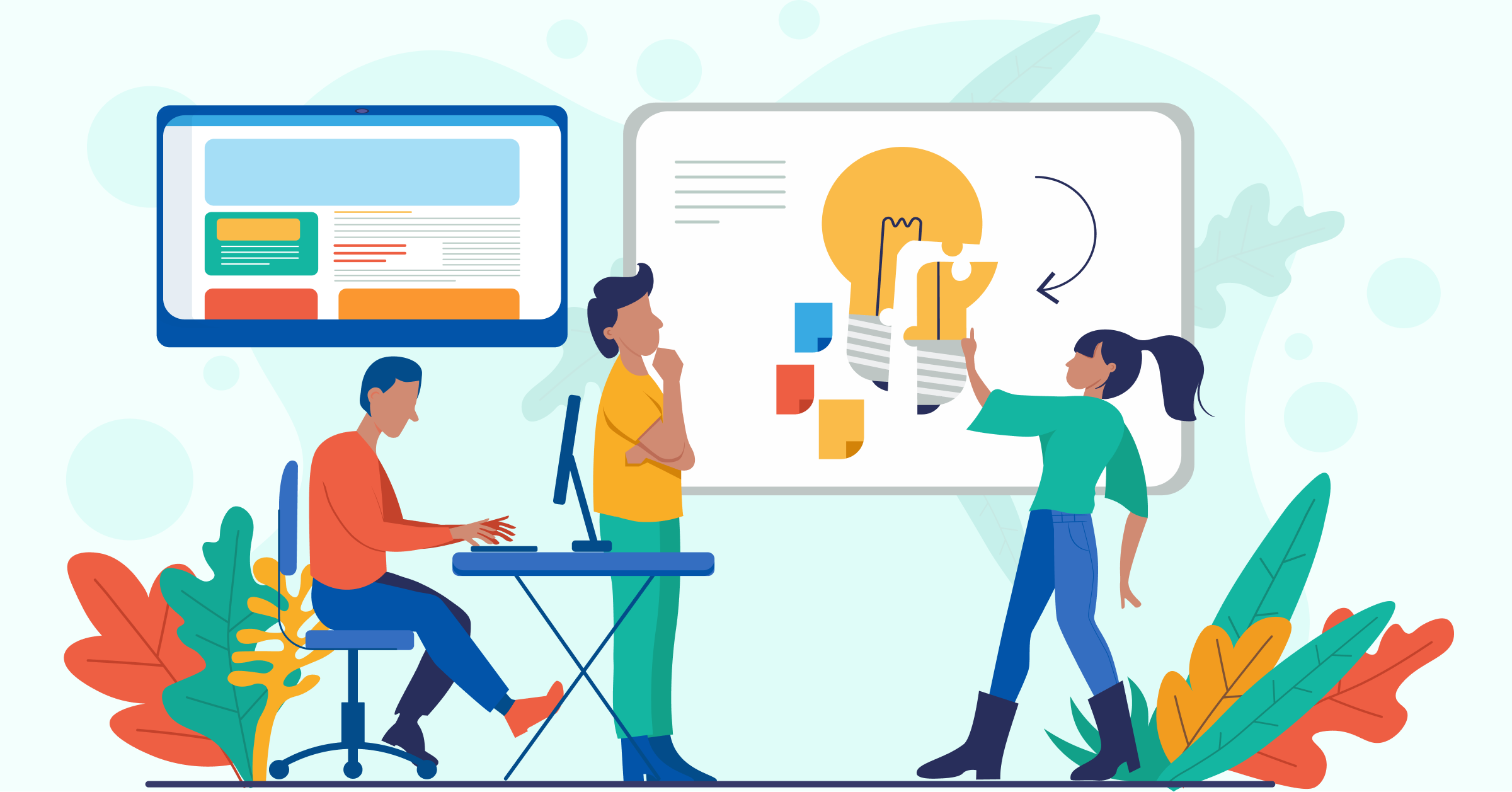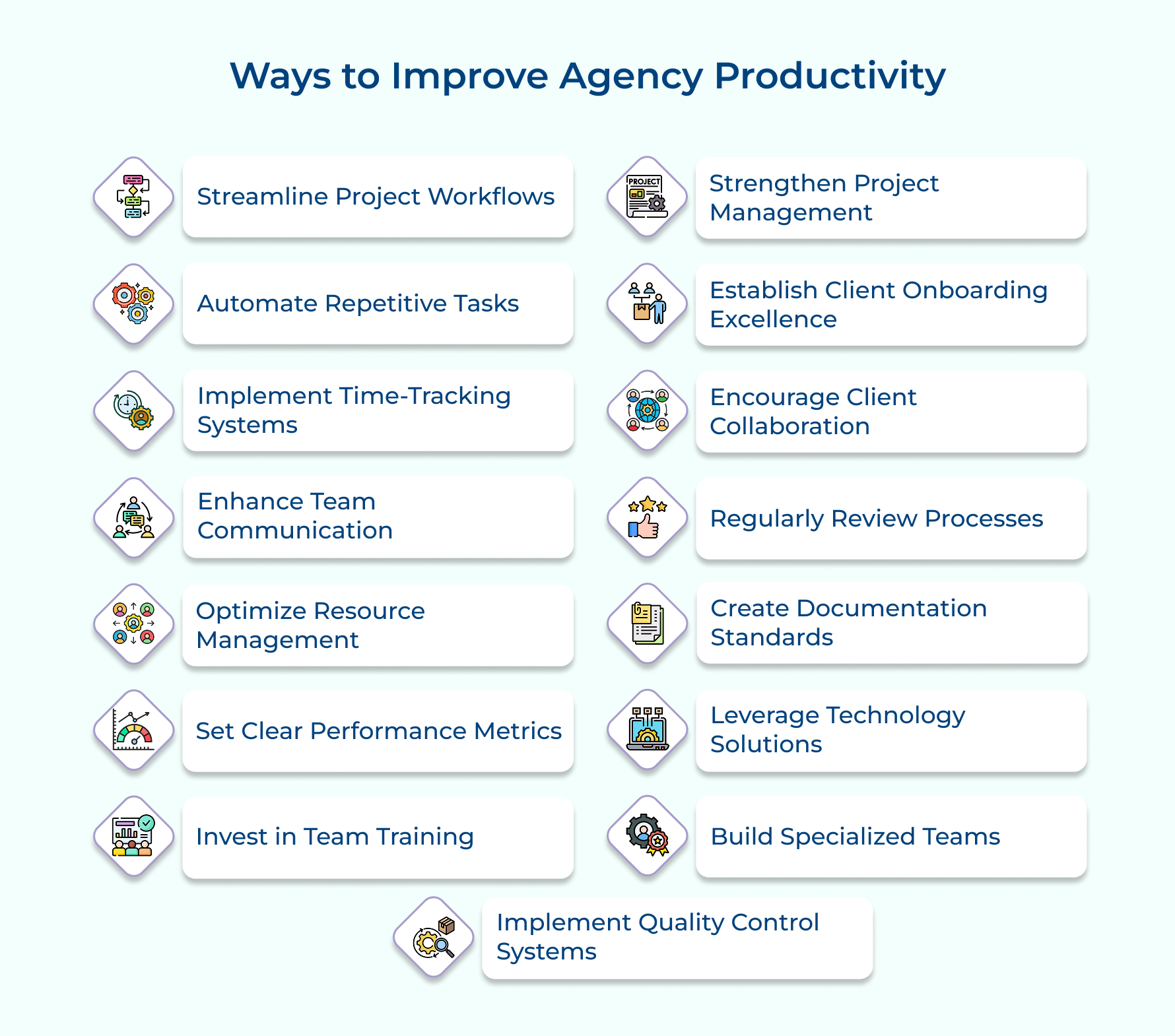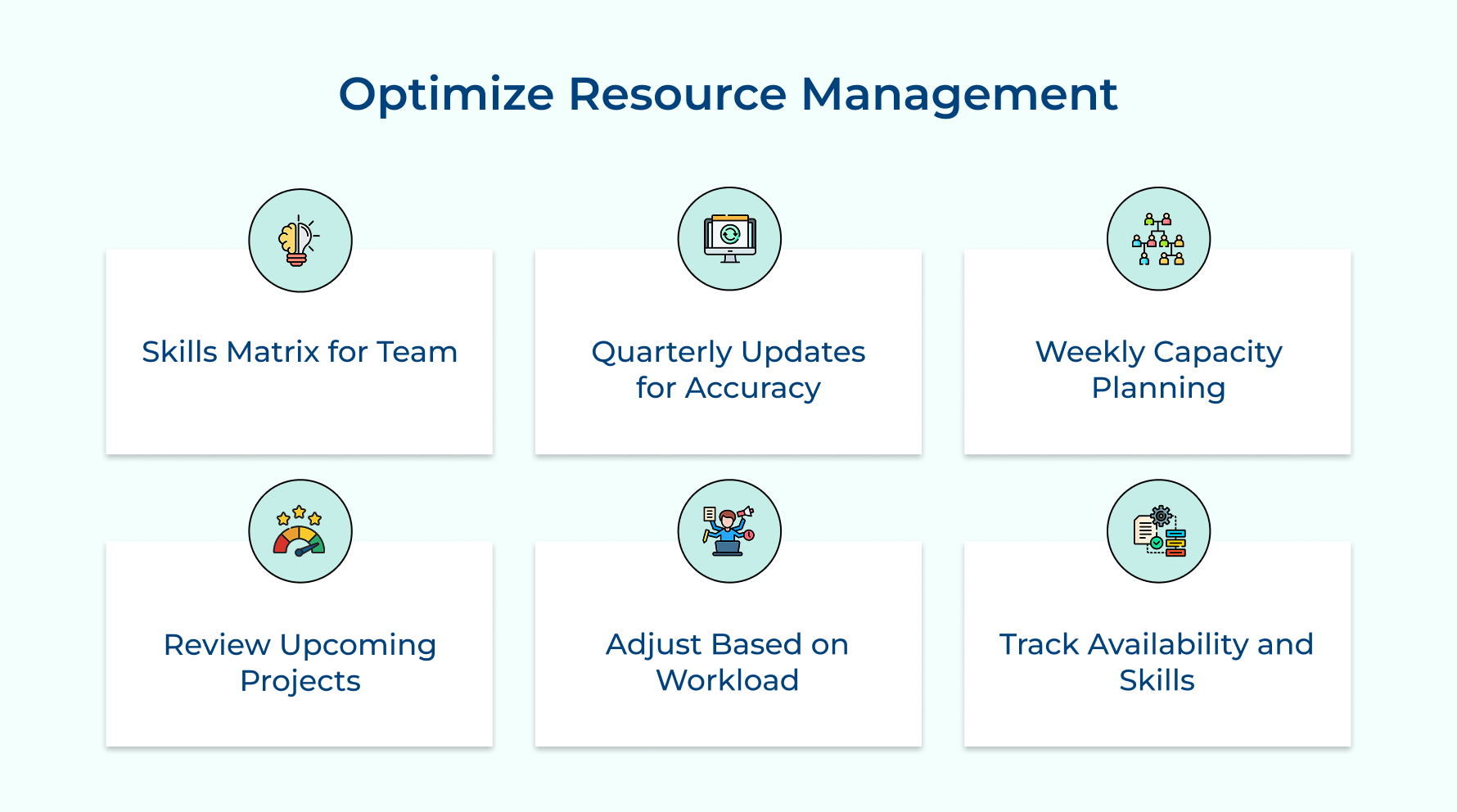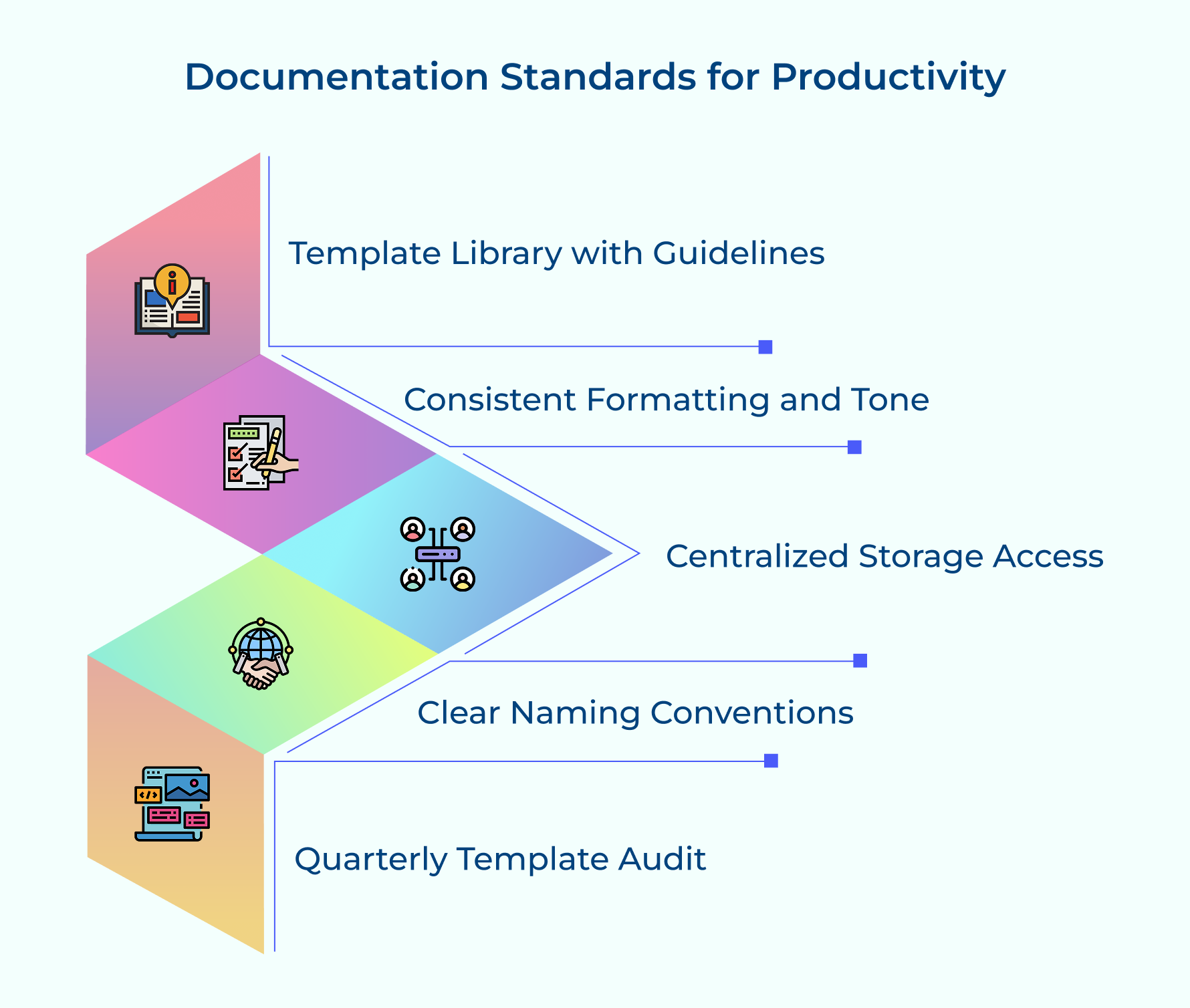15 Proven Ways to Boost your Agency Productivity

Key Highlights:
- Streamlining workflows with templates boosts agency productivity, ensuring faster task completion and reducing inefficiencies.
- Regular process reviews and team feedback help identify bottlenecks, ensuring a high level of performance maintenance.
- Implementing clear quality control systems ensures consistent high-quality deliverables, reducing revisions and enhancing client satisfaction.
Agency productivity is key to staying competitive and delivering outstanding results. Regardless of whether you’re in marketing, creative, or consulting, there’s always pressure to perform at your best.
The secret to success? Streamlining workflows and boosting team efficiency. By implementing the right tools and strategies, agencies can tackle common challenges, improve key performance indicators (KPIs) while enhancing overall performance.
In this blog, we’ll dive into actionable strategies that will help your agency maximize its potential, improve customer experience, and elevate customer interactions.
What is Agency Productivity?
Agency productivity refers to how efficiently and effectively a creative, marketing, or service agency utilizes its resources (including time, talent & technology) to deliver high-quality work to clients while maintaining profitability. It encompasses the entire workflow from project inception to completion, measuring both the quantity and quality of output against the resources invested.
Productive agencies can also invest more time in innovation and strategic thinking rather than being constantly caught up in day-to-day operational challenges. It allows them to stay ahead of industry trends and provide more value to their clients.
Key objectives:
- Maximizing billable hours while minimizing non-billable administrative tasks to ensure optimal resource allocation and profitability.
- Streamlining project workflows and communication channels to reduce bottlenecks while enhancing collaboration between teams as well as clients.
- Implementing scalable processes and systems that maintain consistency in deliverables while accommodating agency growth.
- Balancing workload distribution across team members to prevent burnout while ensuring deadlines are met and quality standards are maintained.
15 Proven Ways to Improve Agency Productivity
Struggling with agency productivity? Don’t worry; we’ve got you covered with 15 proven ways to streamline operations and boost your team’s performance.
1. Streamline Project Workflows
Streamlining your project workflows can make a huge difference in your agency’s productivity. Build a positive work environment while ensuring a productive team by laying out a strong foundation.
- Organize and Optimize: Create clear pathways for completing tasks and standardize methods to handle various project types as well as client needs.
- Reduce confusion: Minimize wasted time by eliminating redundant steps and providing teams with a clear structure to follow.
- Ensure consistency: Standard workflows help maintain quality and meet deadlines consistently.
- Create templates: Map out common project types and create templates for each stage of the process.
- Document procedures: Set clear processes for task handoffs, approvals, and quality checks.
- Use workflow tools: Automate tasks and track progress with workflow management tools to streamline assignments as well as make sure everything stays on track.
Tips to consider:
- Create visual workflow maps for each project type and conduct team training sessions to ensure everyone understands the process steps as well as their responsibilities.
- Implement regular workflow audits to identify bottlenecks and gather team feedback for continuous improvement.
2. Automate Repetitive Tasks
Using software tools to automate routine tasks can significantly boost your agency’s productivity. It’s all about making your team work smarter and not harder.
- Automate routine tasks: Let artificial intelligence handle repetitive tasks like social media posting, email responses, and report generation.
- Save time & reduce errors: Manual handling takes up valuable time and increases the risk of mistakes. Automation ensures accuracy as well as consistency.
- Focus on high-value work: With AI managing routine tasks, your team can shift focus to more strategic and creative work that needs personal attention.
- Identify automation opportunities: Look for tasks that happen regularly and can be automated, making processes more efficient.
- Select the right tools: Choose the appropriate AI tools and create templates or rules to streamline these processes.
Quick Tips:
- Conduct a task audit to identify processes that take up significant time but require minimal creative input, then research tools that can automate these specific tasks.
- Start with small automation projects and gradually expand based on success metrics as well as team feedback.
3. Implement Time-Tracking Systems
Tracking time is crucial for understanding resource usage and keeping projects profitable. Accurately recording time spent on tasks improves project estimation, resource allocation, and billing accuracy. It also helps identify inefficiencies as well as optimize workflows.
Integrating time-tracking software into your project management tools allows for the easy categorization of work and the creation of detailed reports. It also provides regular reviews of data to make informed decisions about staffing and project management.
Pro Tips:
- Select user-friendly time-tracking software with minimal input requirements and train teams on consistent usage practices.
- Establish weekly time review meetings to analyze data and adjust resource allocation based on insights.
4. Enhance Team Communication
Clear and effective communication keeps everything running smoothly in an agency. Without it, teams can face confusion, delays, and costly mistakes. Imagine a client requesting last-minute changes, but the message gets lost in endless email threads—frustrating, right? Using the right communication tools and channels ensures that everyone stays on the same page.
Set up dedicated platforms like Slack for quick updates and project management tools for task tracking. Establish clear guidelines on urgent vs. non-urgent messages to keep workflows focused.
Actionable Tips:
- Create a communication matrix defining which channels to use for different types of messages and establish response time expectations.
- Schedule regular team huddles for quick updates and implement a central knowledge base for important information sharing.
5. Optimize Resource Management
Managing resources wisely is the key to keeping an agency running efficiently without overwhelming the team. When workloads are balanced, projects stay on track, and quality remains high.
Imagine a designer juggling multiple projects while another has free time—proper resource planning prevents such imbalances. Using resource management tools helps track availability, skills, and workloads.
Regular check-ins ensure flexibility for urgent tasks without overburdening the team. A well-planned approach keeps productivity high and burnout low.
Tips to consider:
- Develop a skills matrix for team members and update it quarterly to ensure accurate resource allocation based on capabilities.
- Implement a weekly capacity planning meeting to review upcoming projects and adjust resource allocation accordingly.
6. Set Clear Performance Metrics
Tracking performance through measurable indicators keeps your agency on the right path. Here’s how key performance indicators (KPIs) can help:
- Set clear expectations – Defining KPIs for different roles ensures everyone knows what success looks like.
- Measure progress objectively – Instead of guessing, track performance with real data to see what’s working and what’s not.
- Motivate and align teams – When teams see their progress, they stay engaged and focused on agency goals.
- Use reporting tools – Dashboards and regular reviews keep everyone informed as well as help fine-tune strategies.
Pro Tips:
- Create role-specific scorecards with 3-5 key metrics and establish monthly review sessions to discuss progress.
- Implement a performance dashboard accessible to all team members showing real-time progress against targets.
7. Invest in Team Training
Investing in team development keeps your agency ahead of the curve. How does structured training make a difference? Here’s how,
- Stay updated with industry trends: Regular learning ensures your team is equipped with the latest skills and technologies.
- Boost efficiency and quality: Well-trained employees work smarter, deliver better results, and reduce errors.
- Enhance employee retention: Offering career growth opportunities keeps top talent engaged and motivated.
- Create structured learning plans: Schedule workshops, mentorship programs, and allocate budgets for certifications.
Quick Tips:
- Implement a monthly skill-sharing session where team members teach others about their expertise or recent learnings.
- Create a learning budget for each employee and track their professional development progress quarterly.
8. Strengthen Project Management
Effective project management keeps everything on track and ensures smooth execution. Make it work by:
- Keeping projects on schedule: Clear planning and milestone tracking prevent delays as well as missed deadlines.
- Optimizing resource allocation: Ensure the right people are working on the right tasks at the right time.
- Maintaining quality and budget control: Avoid scope creep and unexpected costs with structured workflows.
- Using the right tools: Project management software streamlines collaboration, reporting, and accountability.
Tips to consider:
- Develop a project kickoff checklist and template that captures all crucial information as well as requirements at the start.
- Schedule weekly project status reviews with standardized reporting formats to identify and address issues early.
9. Establish Client Onboarding Excellence
Bringing a new client on board should feel smooth and professional, setting the stage for a strong partnership.
Imagine a new client signing up for your agency’s services. Without a clear process, they might feel lost or unsure about what happens next. A well-structured onboarding process avoids this.
Start with a welcome package that outlines key contacts, timelines, and expectations. Hold a kick-off meeting to align on goals and workflows. Use process documents to ensure everything runs efficiently from day one.
Pro Tips:
- Develop a digital onboarding portal where clients can access all necessary documents and information in one place.
- Create a 30-60-90 day check-in schedule for new clients to ensure alignment and address concerns early.
10. Encourage Client Collaboration
Building strong client relationships goes beyond delivering great work; it’s about clear communication, mutual understanding, and trust. Let’s say, a client constantly requesting changes because they weren’t aligned on expectations from the start. That’s where structured collaboration helps.
Set up regular check-ins to keep everyone on the same page. Use detailed project briefs to define scope, timelines, and deliverables. Establish a feedback process to gather input early and often, reducing revisions while ensuring smooth project execution.
Quick Tips:
- Establish a client onboarding process that clearly outlines communication expectations and project workflows.
- Create a feedback template for clients to ensure structured and actionable input on deliverables.
11. Regularly Review Processes
Keeping your agency running smoothly isn’t a one-time effort. It requires regular check-ins and adjustments to stay efficient and effective.
- Review workflows regularly to spot bottlenecks and areas for improvement.
- Gather team feedback to understand challenges and find better ways to work.
- Analyze performance data to see what’s working and what needs tweaking.
- Implement small changes and monitor their impact to ensure continuous improvement.
Tips to consider:
- Conduct monthly process review meetings with team leads to identify pain points and suggest improvements.
- Create a process improvement tracking system to monitor the implementation and impact of changes.
12. Create Documentation Standards
Keeping agency documents organized and consistent enhances efficiency. A unified documentation system ensures everyone follows the same standards, reducing confusion and speeding up workflows.
- Create templates for common documents like client reports, proposals, and project plans.
- Set style guides to maintain consistency in formatting, tone, and branding.
- Use centralized storage with clear naming conventions as well as version control to keep everything accessible and up to date.
Quick Tips:
- Build a comprehensive template library with examples and usage guidelines for each document type.
- Implement a quarterly documentation audit to update templates and remove outdated materials.
13. Leverage Technology Solutions
The right tech stack can transform your agency’s workflow, making collaboration smoother and processes more efficient. Choosing the right tools means less manual work, better communication, and smarter decision-making.
- Assess your current tools, are they helping or slowing you down?
- Find software that integrates well with your existing systems to avoid silos.
- Train your team on best practices to maximize efficiency and ensure seamless adoption.
Pro Tips:
- Conduct quarterly technology audits to evaluate tool usage and eliminate redundant or underutilized systems.
- Create detailed onboarding guides for each technology tool with best practices and troubleshooting tips.
14. Build Specialized Teams
Creating specialized teams within your agency can boost both efficiency and expertise. When your team is focused on specific industries or services, they can dive deep into their area, delivering higher-quality work faster and building stronger relationships with clients.
- Organize teams based on expertise, regardless if it’s industry-specific or a particular service.
- Build knowledge-sharing across teams to enhance collaboration.
- Empower your specialized teams with the tools and resources they need to shine.
Tips:
- Develop expertise matrices for team members and organize quarterly skill-sharing sessions within specialized groups.
- Create industry-specific playbooks for each specialized team to document best practices and knowledge.
15. Implement Quality Control Systems
A strong quality control system ensures your agency delivers consistent, high-quality work. For example, if you’re designing a website, review stages for design, content, and user experience can catch issues before presentation.
Peer reviews add another layer of quality assurance, reducing customer issues. This process leads to satisfied customers who trust your agency to deliver on time and meet expectations.
Tips:
- Create role-specific quality control checklists for different types of deliverables and project stages.
- Implement a “fresh eyes” review system where team members not involved in the project conduct final quality checks.
Driving Results with Increased Agency Productivity
Boosting agency productivity is a game-changer in the current competitive environment. By streamlining processes and building improved team collaboration, agencies can unlock new levels of success. As agencies embrace smarter strategies, tools, and technologies, they’ll see significant gains in both profitability as well as workforce morale.
Meeting customer expectations becomes easier when internal operations run smoothly, allowing teams to focus on high-priority tasks and deliver top-quality work. By focusing on productivity, agencies can create an environment of growth and innovation, leading to satisfied clients as well as long-term success.
The path to growth is clear! Enhanced productivity drives not only improved financial outcomes but also a more motivated and engaged team, ultimately empowering the agency to achieve its fullest potential as well as exceed client expectations.
Limit time — not creativity
Everything you need for customer support, marketing & sales.
Neeti Singh is a passionate content writer at Kooper, where he transforms complex concepts into clear, engaging and actionable content. With a keen eye for detail and a love for technology, Tushar Joshi crafts blog posts, guides and articles that help readers navigate the fast-evolving world of software solutions.


